#SOSCP8706
Explore tagged Tumblr posts
Text
Quiz #2
1. Norms
2. RTI
3. 70% of your target audience, 15 times per year
4. Media Metric Impressions is the measure of any type of interaction that a user has with a piece of content. It is not a measure of the number of the unique views, but just a number of times the content is viewed, even if it is by the same person.
5. Unique impressions is the number of times one individual uniquely interacted with content. So if one person clicked on a link 4 times it would still only count as one unique impression.
6. Earned media is the type of media that you do not pay for. For example if buzzfeed were to write an article on your campaign off their own volition that would be earned media. It is marketing that you are not paying for, but are earning.
7. True
8. The Castro
9. GRINDR
10. Q&A
@globalcommunicationproject
0 notes
Text
Quiz #2
1. Fill in the Blank: To ultimately change behavior: the campaign goal was to increase awareness and engagement, in order to change beliefs, change perceived norms, and therefore change intent...established precursors to changing behavior.
2. Which research agency handles the external evaluation contract for the “This Free Life” campaign? B. RTI
3. What is the “gold standard” reach and frequency goal of a behavior change campaign? A. 70% of your target audience, 15 times/quarter
4. Define media metric impressions. Impressions are the number of views of the media, which could include repeated views by some audience members. Impressions only measure number of views of content (not unique views).
5. Define the media metric unique impressions. Unique impressions refers to the number of unique views, or the number of different individuals that have viewed the media at least once. Unique impressions does not count multiple views by the same individual.
6. Define the marketing term earned media. Earned media refers to publicity or campaign exposure that you receive for free, not as a result of paid advertising. This could include press coverage, reposts on social media, and positive reviews (blog post or yelp).
7. YouTube is an example of a broad appeal, but targeted reach opportunity. True
8. The metro station “take over” (advertsiements on the station floor, stairs, and walls) described in the lecture occurred in which neighborhood in San Francisco? The Castro
9. Which app was more effective at reaching members of the LGBT community? GRINDR
10. The campaign makes extensive use of influencers. Some of these influencers are YouTube influencers, with their own popular YouTube channels. What format did these YouTube influencers use to create content for the campaign? B. Q&A
@globalcommunicationproject
0 notes
Text
Quiz 2 Answers
1. Norms
2. RTI
3. A
4. Impressions: The number of views/the number of times a web page is loaded.
5. Unique Impressions: The number of views/the number of times NEW PEOPLE open/load a webpage.
6. Earned Media refers to attention/awareness for your campaign that was not bought/paid for. It is the amount of attention your campaign gets through something like a news story about your campaign that wasn’t planned or paid for.
7. True
8. The Castro
9. GRINDR
10. B- Q & A
@globalcommunicationproject
0 notes
Text
Quiz #2
1. FILL IN THE BLANK
To ultimately change behavior: the campaign goal was to increase AWARENESS and ENGAGEMENT, in order to CHANGE BELIEFS, CHANGE PERCEIVED ____NORMS____________, and therefore change INTENT… established precursors to changing BEHAVIOR.
2. Which research agency handles the external evaluation contract for the This Free Life campaign?
A. ICF
B. RTI**
C. Banyan
D. CrossMedia
3. What is the “gold standard” REACH and FREQUENCY goal of a behavior change campaign?
A. 70% of your target audience, 15 times a quarter**
B. 70% of your audience, 20 times a quarter
C. 75% of your audience, 15 times a quarter
D. 75% of your audience, 15 times a quarter
4. Define the media metric IMPRESSIONS in 1-2 sentences.
Impressions is the number of times people have come in contact with your campaign marketing content.
5. Define the media metric UNIQUE IMPRESSIONS in 1-2 sentences.
Unique impressions is the number of people have come in contact with your campaign marketing content (i.e. not counting the repeated times they have seen it).
6. Define the marketing term EARNED MEDIA in 1-2 sentences.
Earned media is the media coverage and publicity that comes from doing things such as hosting events that promote your campaign.
7. Is YouTube an example of a BROAD APPEAL, BUT TARGETED REACH opportunity? (circle or underline one)
T** / F
8. The metro station “take over” (advertisements on the station floor, stairs, and walls) described in the lecture occurred in which neighborhood in San Francisco?
Castro!!
9. Which app was more effective at reaching members of the LGBT community? (circle one)
GRINDR** or OKCUPID.
10. The campaign makes extensive use of influencers. Some of these influencers are YouTube influencers, with their own popular YouTube channels. What format did these YouTube influencers use to create content for the campaign? (circle one)
A. Spoken Word
B. Q & A**
C. Reading Mean Tweets
D. Animation
@globalcommunicationproject -- I’m ready to take on Part 2!
0 notes
Text
Quiz 2
Quiz #2
1. FILL IN THE BLANK
To ultimately change behavior: the campaign goal was to increase AWARENESS and ENGAGEMENT, in order to CHANGE BELIEFS, CHANGE PERCEIVED __NORMS__, and therefore change INTENT… established precursors to changing BEHAVIOR.
2. Which research agency handles the external evaluation contract for the This Free Life campaign?
A. ICF
B. RTI
C. Banyan
D. CrossMedia
3. What is the “gold standard” REACH and FREQUENCY goal of a behavior change campaign?
A. 70% of your target audience, 15 times a quarter
B. 70% of your audience, 20 times a quarter
C. 75% of your audience, 15 times a quarter
D. 75% of your audience, 15 times a quarter
4. Define the media metric IMPRESSIONS in 1-2 sentences.
Impressions are the number of times your ad/content was viewed, inclusive of all views/visits, duplicates included.
5. Define the media metric UNIQUE IMPRESSIONS in 1-2 sentences.
Unique impressions are the number of people who viewed/visited your ad/content. So if one person viewed the piece 10 times, that would be one unique impression.
6. Define the marketing term EARNED MEDIA in 1-2 sentences.
Earned media is another way of saying PR. It’s when people start talking about your campaign/product in the public space, independently.
7. Is YouTube an example of a BROAD APPEAL, BUT TARGETED REACH opportunity? (circle or underline one)
T / F
8. The metro station “take over” (advertisements on the station floor, stairs, and walls) described in the lecture occurred in which neighborhood in San Francisco?
The Castro
9. Which app was more effective at reaching members of the LGBT community? (circle one)
GRINDR or OKCUPID.
10. The campaign makes extensive use of influencers. Some of these influencers are YouTube influencers, with their own popular YouTube channels. What format did these YouTube influencers use to create content for the campaign? (circle one)
A. Spoken Word
B. Q & A
C. Reading Mean Tweets
D. Animation
0 notes
Text
Quiz Part 1
Q1: Norms
Q2: RTI
Q3: 70% of your target audience, 15 times a quarter
Q4: Number of times people have looked at your content. This is counted every time content is displayed to a visitor including repeated viewings.
Q5: Number of times a person sees content for the first time. This is counted every time a visitor views content for the first time and it relies on information from cookies stored in your visitors’ browser.
Q6: Earned media is content created by users of your content through mentions, shares, and reposts. This type of media is not created through paid promotion, but through other content generators talking about your product or service.
Q7: True
Q8: The Castro
Q9: OKCUPID
Q10: Q & A
@globalcommunicationproject
0 notes
Text
Quiz 2
1. FILL IN THE BLANKTo ultimately change behavior: the campaign goal was to increase AWARENESS and ENGAGEMENT, in order to CHANGE BELIEFS, CHANGE PERCEIVED ___norms___________________, and therefore change INTENT… established precursors to changing BEHAVIOR.
2. Which research agency handles the external evaluation contract for the This Free Life campaign?
A. ICF B. RTI C. Banyan D. CrossMedia
3. What is the “gold standard” REACH and FREQUENCY goal of a behavior change campaign?
A. 70% of your target audience, 15 times a quarter B. 70% of your audience, 20 times a quarter C. 75% of your audience, 15 times a quarter D. 75% of your audience, 15 times a quarter
4. Define the media metric IMPRESSIONS in 1-2 sentences.
Impressions are essentially the number of times the content has been seen over the time you are measuring. 100 impressions could be 1 person seeing the content 100 times or 100 people seeing the content 1 time each.
5. Define the media metric UNIQUE IMPRESSIONS in 1-2 sentences.
Unique impressions are the number of individuals who have seen the material. This does not count repeat views, it is only the raw number of people who have seen the content. In the example above, the first one would be 1 unique impression and the second would be 100 unique impressions.
6. Define the marketing term EARNED MEDIA in 1-2 sentences.
Earned media is like getting media coverage without paying for it but because you have done something. It would be like the Today show covering This Free Life because they noticed it on YouTube and thought it was such an interesting campaign they wanted to share it.
7. Is YouTube an example of a BROAD APPEAL, BUT TARGETED REACH opportunity? (circle or underline one)
T / F 8. The metro station “take over” (advertisements on the station floor, stairs, and walls) described in the lecture occurred in which neighborhood in San Francisco?
The Castro 9. Which app was more effective at reaching members of the LGBT community? (circle one)
GRINDR or OKCUPID.
10. The campaign makes extensive use of influencers. Some of these influencers are YouTube influencers, with their own popular YouTube channels. What format did these YouTube influencers use to create content for the campaign? (circle one)
A. Spoken Word B. Q & A C. Reading Mean Tweets D. Animation
@globalcommunicationproject
0 notes
Text
Comparing Health Departments


@globalcommunicationproject
0 notes
Text
PhillyPH v. BostonPH
Forget football y’all, here’s the Philly-Boston square off we’ve all been waiting for: Who’s PH dept is better at the ‘Book?
Before The roast begins, let’s just give some credit where it’s deserved–at least they both have active Facebook pages with at least minimally a few thousand followers. Philly clocks in at 5,165 followers for a city of just over 1.5 mil. Boston fares a little bit better with 5,103 followers for a much smaller city of just over 660K. For some perspective, the National Health Service for the entire COUNTRY of England, with a population of over 54 million people, has under 2 large. Poor NHS really needs some attention :( I can practically taste the desperation, just look at their last post:

“Just, please share. Please. We’ve already lost like 450 million friends this year and we really need some love.” (#brexit)
So, it could be worse guys. #itsallrelative
Let’s start with the Boston Public Health Commission Facebook page. LikeRank: 55
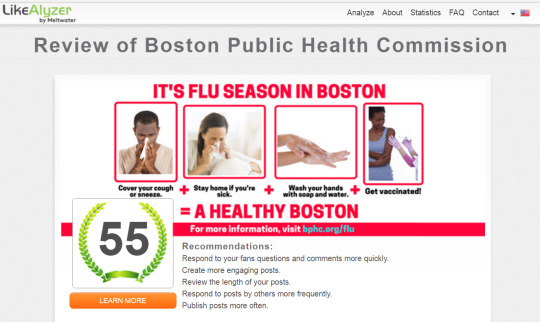
What Boston does well:
The Boston page does a nice job of speaking in a social-media appropriate language: emojis, hashtags, even some abbrevs snuck in there. But it does it in a way that maintains credibility (as in, they don’t sound like my Aunt Mable who just joined Facebook and thinks its still cool to say 2 instead of too and u instead of you *eye roll* this isn’t Xanga circa 2000, Mable). I found this appealing.
They diversify content and voice: A health department’s social media account has the difficult task of appealing to a broad and diverse audience with authentic content. Boston, I think, does a nice job of diversifying it’s voice and the type of content it posts–it switches it up between photo, link, and text posts. I think this is helpful in appealing to a diverse audience that have differing preferences when it comes to what kind of content they want to see.
They post original content. We’ll get to Philly a little later on, which posts next to zero original content–in comparison, Boston posts a lot of original content. Infographics, posters, photos, all of which drive people to BPHC rather than away from it (to other pages, organizations, etc.) I think this helps bolster the BPHC brand, and establishes it as a trusted source for content rather than just a purveyor of it.
What Boston does less well:
Using hashtags: OK, so it’s not that they don’t use hashtags–they do, a lot of them–but that they don’t always use them in an appropriate way. More than just being the socially-acceptable way to talk on social media, hashtags are a helpful way to expand your audience by connecting your post to a broader group of people who are looking at similar posts. But from a public health perspective, hashtags that are too general, or reach the wrong audience, are not going to help you connect with who you want to connect with. As an example, BPHC posted the following using the hashtag #WeCanHelp
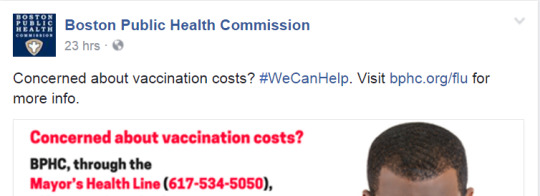
You can help? Great, according to Facebook so can Texas Tower Passport and Visa Services, Roses Restaurant and Bakery Sherwood (OR), and WhizBang! Training. Point being, the hashtag #WeCanHelp is so widely used by geographically, topically, and demographically disparate users that it’s not going to help broaden your audience within the public health community or the Boston community. There are several examples of hashtags like this on the Boston page. Though it’s important to note that BPHC does also use more appropriate hashtags like #rethinkyourdrink and #oralhealthoverallhealth
Next: Toooooo many awareness months. According to BPHC, September is supposedly Sepsis Awareness Month, Rabies Awareness Month, Recovery Awareness month, Infant Mortality Awareness Month, National Preparedness Month, and National Rollerskate Collision Awareness Month. And I only made one of those up.
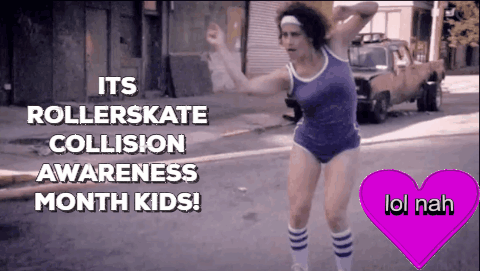
(National Rollerskate Collision Awareness Month although interestingly enough, rollerskate collisions is a real medical condition recognized by the new ICD-10 diagnosis coda, along with being sucked into a jet engine, subsequent encounter, and Burn due to water-skis on fire<–I can totally relate to this one. Don’t ask.) The whole point of an awareness month is to make a concentrated effort to focus on and raise awareness about a specific cause–it’s an all hands on deck, let’s all rally around one particular issue. You defeat the purpose and dilute interest when you post about 5 different awareness months in the same month.
Last but not least, relatedly, the page posts about too many campaigns without following through on most of them. The page launched a campaign about preparedness, saying they’d post daily about tips to help you stay safe…but then the next two posts are about HIV and rabies from unrelated campaigns? It makes for a muddled message, and the end result is that while there’s a TON of great information on there, none of the campaigns really gain enough momentum to warrant following and further engaging with them.
Moving on: The Philadelphia Department of Public Health Facebook page. LikeRank: 53, about on par with Boston.
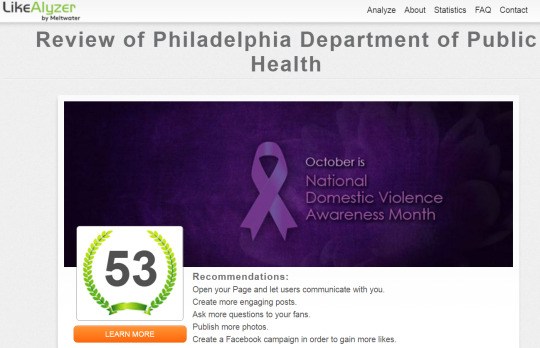
We’ll start again with what they do well:
They leverage VIPs to bolster interest: People like to fangirl over celebs, and are more likely to be interested in boring stuff like prostate cancer (v. important, but still boring to most) when Ben Stiller tells you to, or heart disease when Queen Latifah tells you to be. And we’re definitely more likely to be interested in childhood obesity when our other Queen, Michelle Obama, tells us to be. And in fact, the post about Queen Latifah was the second most liked post on the page in the last few weeks (with a whopping 9 likes. Michelle got 13 a while back. The real question is who are these other monsters NOT liking Michelle Obama…). They could take this further and even get influencers to post on their behalf/link to their page.
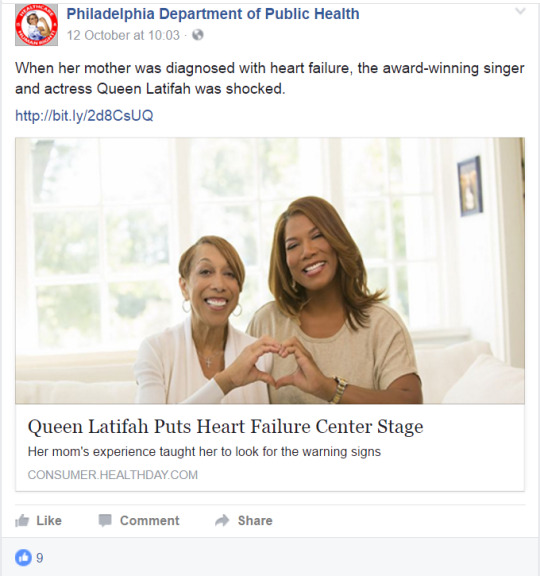
They post Philly specific stuff: Philly is a great city! Full of awesome stuff, let’s celebrate and share the fun, healthy stuff happening in this city while also talking about other important, national, public health stuff! The page often shares posts about cool cultural events happening in the city, about great public spaces around town to enjoy actively or socially, tips from local experts, and awards or recognition the city has received. I think this is a great way to boost engagement and position the BPHD brand as a trusted source not just for public health info, but also for philly pride/local happenings. It also enhances relevance (important to facilitating central processing of information). Reading an article about the health benefits of exercise is one thing, but being told about a cool local event that just *happens* to involve exercise is another—its a less conspicuous, more practical way of not just getting a message across, but actually facilitating action.
Civic Literacy/Civic Engagement: The BPHC facebook page does a great job of encouraging civic engagement on issues important to public health in the community. For example, they regularly post about how to register to vote and upcoming voter registration deadlines, as well as information about proposed bills that have implications for public health in the philly community. Beyond that, they also occasionally post in a way that situates public health issues in a civic perspective. See below on connecting tobacco marketing to poverty. I think this is a really great way to appeal to the justice-seeking side of their followers in addition to the health-seeking.
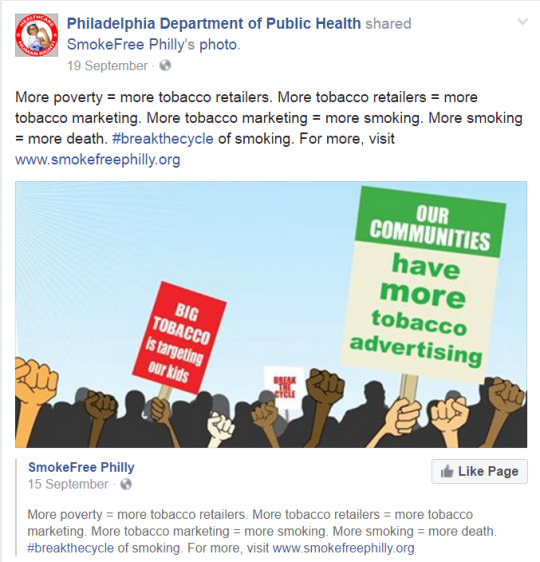
#downwithbigtobacco #sooverit
Now, onto what they don’t do so well:
No original content: They don’t really post any of their own content–everything they post is linking to external sources and organizations. The implication of this is that they are not positioning themselves, the Philadelphia Public Health Department, as a source for quality, original public health content and information. Rather, they’re just someone that posts a lot of informative links. Further, they drive traffic away from them as opposed to back to them. Not good for establishing and growing their brand. This may be in part why their likes growth rate (.058%) is abysmal.
No shareable/likeable content: So, this sounds harsh, and I don’t mean to say they’re not posting interesting or important content, it’s just that they’re not (at least not regularly) posting content in a manner that encourages sharing and engagement. You know, great to let folks know that it’s National Depression Screening Awareness Day, but what about letting them know how important it is to share this information with their friends and family? Better yet, what about posting something, idk, FUNNY or entertaining in some way that someone might want to share? A meme? a gif?
They don’t respond to their followers: This one is just unacceptable. Ok so buckle up and listen to this…back in September, BPHD posted an article about the issue of corporal punishment/child abuse, with a caption directly asking “You’re in the supermarket and you see a parent hit their child. What do you do?” DAMN, good question, what would I do??! Ok, so THEN, one of their followers ACTUALLY RESPONDS (this is unheard of y’all, at least for the BPHD facebook page):
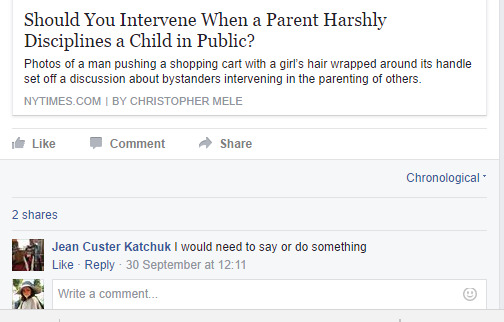
………………………………………………
………………………………………………………..
……………………………………………………………………
……………………………………………………………………………..
………………………………………………………………………………………..
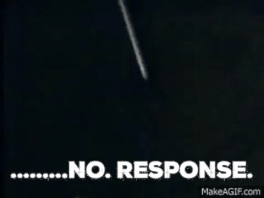
They GHOSTED Jean. Girl I have been there. Poor Jean is still waiting for a text back a month later, wondering if she said something stupid or put herself out there too much or misread the question or was too forward or……..wait I’m projecting. But you get the point–you finally got someone to engage and then you don’t validate that engagement with a response? What was the ducking (*iphone autocorrect) point in asking a question to begin with, then? No wonder your users aren’t engaging with you, it’s like talking to a brick (facebook) wall.
Jean—I just want to say that, I hear you, and me too.
All in all, I want to first emphasize that I think both Boston and Philly do a really wonderful job leveraging Facebook to reach their audience, and everything in this post is meant to be in good fun, and as an academic exercise/practice in analyzing social media use in public health. Next, I want to make the point that I don’t think public health should be as afraid of having a personality on social media. I feel like we are just seen as, like, the narcs everywhere we go….and it doesn’t have to be like that!
We can change what it means to be a cool mom. *mic drop*

@globalcommunicationproject
1 note
·
View note
Photo


The New York City Department of Health and Mental Hygiene (NYCDOHMH) and Los Angeles County Department of Public Health's (LACDPH) Facebook pages both include page information such as page name, organizational category, and website. Both organization's Facebook pages also have a distinct username that allow Facebook users to quickly reach the page. Unfortunately, NYCDOHMH forgot to fill in the "About" section and LACDPH has only like a meager 7 pages. Neither page has created a milestone. NYCDOHMH leaves LACDPH in the dust when it comes to page performance. NYCDOHMH is the clear champion with 19,240 likes, 6.3% likes growth, 1,646 "People Talking About This" (i.e., PTAT: number of unique people who have created a story about the page), and 8.56% engagement rate (i.e., PTAT divided by total number of likes). Comparatively, LACDPH has 2,591 likes, but their likes growth is half that of NYCDOHMH, their PTAT is 35, and their engagement rate is only 1.35%. Both health departments do a mediocre job at creating interesting and engaging posts. Although both health departments are posting about once a day and using hashtags to ensure a broader audience will see their content, these pages need to improve the number of likes, comments, and shares per post; timing of posts; and asking more questions of their fans. NYCDOHMH and LACDPH could also improve how they field posts by others. On the LACDPH page, fans cannot post. On the other hand, NYCDOHMH allows fans to post, but then only responds to 3% of these posts in an average time of 22.35 hours. Recommendations 1. Inform Facebook fans about compelling health department history through milestones. 2. Include information in the "About" section to inform Facebook users about the organization's purpose and potential relevance. 3. Like and engage with as many related pages as possible to increase traffic to the health department's page. 4. Post content that has historically gained positive attention, like information about health services (see pictures), when Facebook users are on the site. 5. Allow health department Facebook pages to be places for people to express their negative and positive feedback and make sure the health department responds in order to increase public health's credibility and authority. @globalcommunicationproject @nychealth
1 note
·
View note
Text
It Takes 1000!
This post refers to the campaign It Takes 1000! This campaign aims to educate parents about the importance of eating well, play, and protection and safety in the first 1000 days of a child's life. This gif targets the engaged progressive parent.
via GIPHY
This gif targets the detached parent.
via GIPHY
This parents targets the faithful parent.
via GIPHY
@globalcommunicationproject
0 notes
Photo



Parents Give 1000 Campaign
The first 1000 days are critical to the development of any child, and it is important that all kids recieve the correct nutrition during the first 1000 days of life. The #parentsgive1000 campaign targets three different type of parents to motivate them to give their all to their children in the first 1000 days of life. @globalcommunicationproject
0 notes
Text
Eat. Play. Love.
Early stimulation and interaction with parents and caregivers jumpstarts brain development and promotes well-being. Caregivers in sub-Saharan Africa create learning opportunities for their children through play. #EatPlayLove #EarlyMomentsMatter @globalcommunicationproject
Ambassadors: http://giphy.com/gifs/13x8v6sSb9MI8M
Good Intentions: http://giphy.com/gifs/rPPSxJjDsIuZ2
Tea-Sippers: http://giphy.com/gifs/ZFTzt7dRXCO2s
0 notes
Text
UNICEF Campaign
This campaign relates to 3 different topics we have a Mommy blogger, “When I have time” mom and a Pinterest Mom @globalcommunicationproject
Mommy Blogger: <iframe src="//giphy.com/embed/KgUM2qb91Z3K8" width="480" height="480" frameBorder="0" class="giphy-embed" allowFullScreen></iframe><p><a href="http://giphy.com/gifs/mommy-blogger-KgUM2qb91Z3K8">via GIPHY</a></p>
“When I have time” mom: <iframe src="//giphy.com/embed/MVzeMQ3QZ2MCc" width="480" height="480" frameBorder="0" class="giphy-embed" allowFullScreen></iframe><p><a href="http://giphy.com/gifs/when-i-have-time-mom-MVzeMQ3QZ2MCc">via GIPHY</a></p>
Pinterest Mom: <iframe src="//giphy.com/embed/TSvuS6qIqXiAU" width="480" height="480" frameBorder="0" class="giphy-embed" allowFullScreen></iframe><p><a href="http://giphy.com/gifs/pinterest-mom-TSvuS6qIqXiAU">via GIPHY</a></p>
0 notes
Text
Parents Give 1000 Campaign
Give your baby 1000% in their first 1000 days. Sign up to get your baby box from the Give 1000 campaign.

go to: gph.is/2dxcoDj
http://gph.is/2dxcoDj
involved parent

go to: gph.is/2e5ndli
http://gph.is/2e5ndli
detached parent

go to: gph.is/2eax7Ow
http://gph.is/2eax7Ow
faithful parent
@globalcommunicationproject
1 note
·
View note
Text
Parents Give 1000 Gifs
This first gif would be targeted to the “Engaged Progressive Parent.” The message included with the gif would be “You are your child’s biggest fan” and would suggest that these parents keep doing what they are doing to provide quality nutrition, stimulation, and protection to their kids. This would play to this persona’s current behaviors of being an involved parent.
via GIPHY
The second gif would be targeted to the “Detached Parent.” The message included with the gif would be “There’s so much you can do” and would tell parents that even small changes in nutrition, stimulation, and protection can have great effects on your kids. This would play to this persona’s belief that there is little they can do to influence their kids.
via GIPHY
The third gif would be targeted to the “Faithful Parent.” The message included with the gif would be “Love at home” and would let parents know that their ability to provide quality nutrition, stimulation, and protection at home is extremely important. This would play to this persona’s belief that outside influences on their children could be harmful.
via GIPHY
@globalcommunicationproject
0 notes